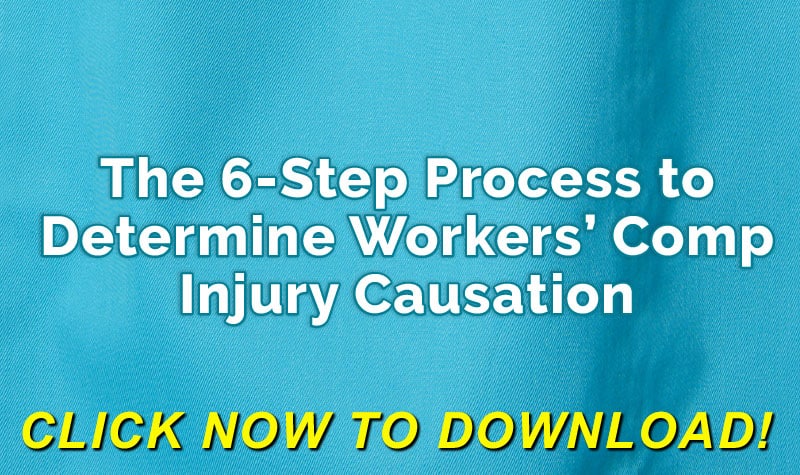Focusing on generics instead of brand name drugs, and in-network pharmacies instead of third-party billers are among the ways payers can help reduce their workers’ compensation costs while still ensuring quality care. Taking a deeper look into where and how the industry spends money on pharmaceuticals reveals many additional things organizations can do to eliminate unnecessary expenses for medications.
A recent report on drug trends within the workers’ compensation system shows, for example, that brand name abuse-deterrent formulations for opioids cost on average $520.85 more per prescription than non-brand abuse deterrent formulations (ADFs). Even though these medications are not typically included in workers’ compensation formularies (unless by client request), they are having an impact, according to the Drug Trends Report from Express Scripts.
Click Link to Access Free PDF Download
“The 6-Step Process To Determine Workers’ Comp Injury Causation”
Steps to eliminate wasteful Rx spending include:
- Educate providers and patients about the risks and benefits of opioids, and consider alternatives for chronic pain by using evidence-based guidelines.
- If an ADF is requested, consider whether the patient is at risk of abuse when considering whether to approve the medication and if they can use a more traditional opioid. Likewise, if an overdose antidote is requested because of overdose risk, consider less expensive alternatives to Evzio where possible, such as narcan, naltrexone or naloxone.
- Look closely at dermatologicals that are prescribed; consider lidocaine rather than the more expensive Lidoderm.
- Closely review prescriptions for compound medications to see if they are truly needed for the patient. Likewise, for physician-dispensed drugs.
- Educate and encourage providers to use of generics rather than brand name drugs, where possible.
- Avoid third-party billers if possible.
- Closely review and watch prescriptions of specialty medications.
Below is a look at several categories of medications prevalent in the workers’ compensation system and where payers can reduce their costs.
Opioids
These remain the most expensive and most utilized class of drugs in workers’ compensation, despite industry and governmental efforts to stem their abuse. Express Scripts said they accounted for 26.6 percent of per-user-per-year (PUPY) spend and 24.3 percent of PUPY utilization among its clients. The good news is that spending on opioids decreased last year.
Still, more than half of injured workers — 50.9 percent had an opioid prescription last year, and 25 percent of injured workers used them for at least 30 days.
Patient and provider education is key to reducing utilization and prescribing of these drugs so that they are used according to evidence-based guidelines in the more acute phases of pain, rather than injured workers with chronic pain.
The use of ADFs among injured workers increased by 50 percent from 2015 to 2016. Typically, a payer must approve the medication prior to dispensing due to the cost of the drug and the need to assure that it’s appropriate for the injured worker.
If you receive a request for an opioid overdose antidote, look at the specific drug noted. Several versions are on the market, including naloxone; Narcan®, (naloxone); naltrexone; and Evzio, as self-injectable form of naloxone. It is important to note however, “the average cost per prescription for Evzio was $3,380.69 higher than for Narcan, naltrexone and naloxone combined,” according to the Express Scripts report.
Dermatologicals
Of the top 10 drug therapy classes, the total spend per class decreased on 7 of the 10 classes between 2015 and 2016. Among those with an increase were dermatologicals, which had a spending increase of 1.3 percent. The 10 percent increase in the average cost per prescription was moderated by a 9.5 percent decrease in utilization, according to the 2016 Drug Trend Report.
Generic versions of Voltaren® gel helped decrease utilization of the brand name drug, and should be considered by payers.
Prescriptions of lidocaine decreased, and the average cost per prescription is almost half that of Lidoderm — a lidocaine patch. Even though Lidoderm only had 4.2 percent of market share in 2016, the cost increased nearly 28 percent from the previous year.
Compounded Medications
Spending on these has decreased considerably in recent years, mainly due to a decrease in utilization. However, these are still seen as a significant cost driver in the workers’ compensation system. Medical treatment guidelines generally do not consider these a first line therapy for conditions typical of injured workers. They are excluded from most formularies and require prior authorization.
The cost of compounded drugs “averaged $1,966.92 per prescription in 2016 compared to $1,558.14 in 2015,” according to Express Scripts.
Physician Dispensing
These cost “$109.19 more than drugs dispensed by pharmacies,” the Drug Trend Report said. More than 38 percent of physician dispensed drugs are for pain or pain/inflammation.
The top physician dispensed drugs in 2016 according to Express Scripts were meloxicam, cyclobenzaprine, gabapentin, tramadol and Mapap® (acetaminophen).
Generics
Generics are identical in effectiveness to brand name drugs. Nevertheless, prescribers may turn to brand name drugs due to “habit, lack of awareness of available alternatives or patient request,” according to Express Scripts. “Injured workers create waste by requesting brand-name drugs instead of generics. Workers’ compensation payers can create unintentional waste when, to limit potential disruption, they fail to adopt programs that encourage the use of equally effective, lower cost options.”
Network Pharmacies
Prescriptions that are filled through third-party billers or out of network pharmacies “incur additional costs, with no additional value,” according to Express Scripts. The company noted that payers using its network pharmacy system spent 15 percent less than through third-party billers.
Specialty Drugs
These account for less than 1 percent of drugs used by injured workers, however the costs for them can add up. Spending on them increased 3.2 percent in 2016 and represented 5.9 percent of total spending, among Express Scripts’ clients.
There was a 46.9 percent increase in spending for the HIV drug Truvada® prescribed for pre-exposure prophylaxis; spending on Xyrem® (sodium oxybate) in the therapy class of psychotherapeutic and neurological agents (anticataplectic agents) increased 68.6 percent; and Xolair® (omalizumab), an asthma medication saw a 64.3 percent increase in spending. Client spend on specialty medications varies, largely dependent on the injured worker population covered by the client.
Conclusion
Ensuring injured workers get the best medical care for optimal outcomes should not be contingent on spending on unnecessary medications. Payers can control their costs for medications and still provide quality care.

Author Michael Stack, CEO Amaxx LLC. He is an expert in workers compensation cost containment systems and helps employers reduce their work comp costs by 20% to 50%. He works as a consultant to large and mid-market clients, is co-author of Your Ultimate Guide To Mastering Workers Comp Costs, a comprehensive step-by-step manual of cost containment strategies based on hands-on field experience, and is founder & lead trainer of Amaxx Workers’ Comp Training Center.
Contact: mstack@reduceyourworkerscomp.com.
Workers’ Comp Roundup Blog: https://blog.reduceyourworkerscomp.com/
©2017 Amaxx LLC. All rights reserved under International Copyright Law.
Do not use this information without independent verification. All state laws vary. You should consult with your insurance broker, attorney, or qualified professional.







